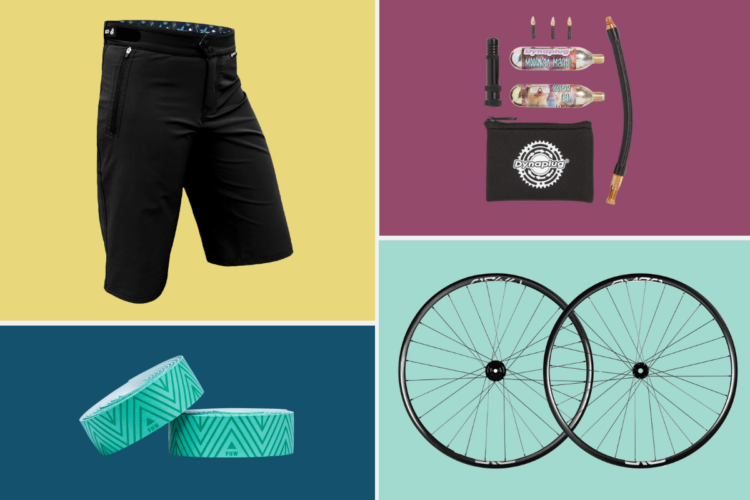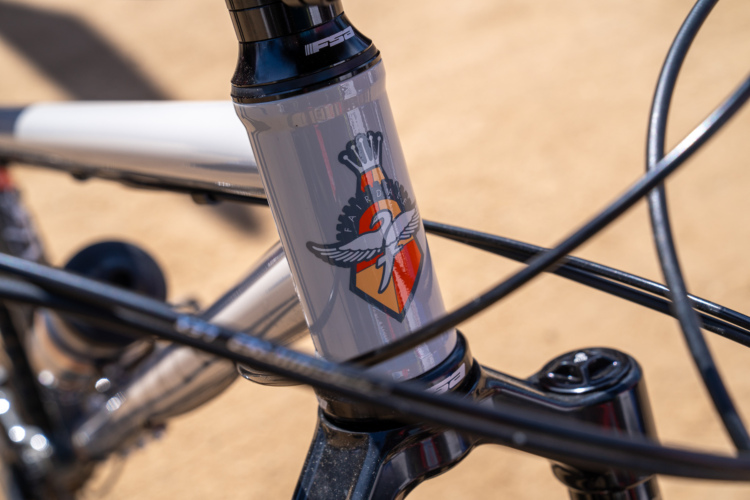
With the explosion of the gravel bike category over the past couple of years, the lines have only become blurrier between gravel and mountain biking. But even with all the new sub-disciplines of gravel, it still may never catch up with all of the sub-disciplines already present in mountain biking.
As the category has been sliced and sliced again, like a pizza trying to feed too many people at a party, brands have been trying to catch up with specialized products. We first caught wind of the Fox AX gravel fork a few years ago, but it appeared to be more of a mountain bike fork missing 60mm of travel than a dedicated gravel fork.
Last year, Fox released the 32 Taper-Cast Gravel fork, or 32 TC for short, and it is distinct from the earlier AX model.
Fox 32 TC Gravel Fork Key Specs
- Kashima-coated stanchions
- “Gravel Tuned” FIT4 damper, 3-position adjust
- Adjustable low speed compression and low speed rebound
- 40/50mm travel depending on model
- 45, 50mm rake options
- 1.5″ tapered steerer
- Compatible with 160/180mm brake rotors
- 700c wheels only
- Weight: 1,226g
- Price: starting at $769 for Performance TC. $949 for Fox 32 Factory TC as tested.
- Buy from Backcountry.

The Fox 32 TC gravel fork
Fox calls the 32 TC the “lightest suspension fork” they have ever built. That’s probably accurate, considering the design of the fork. With only 40-50mm of travel, Fox can shave off or “taper” the legs of the fork to save weight. A suspension fork is always going to be heavier than the rigid carbon fork that comes with most gravel bikes, but if you’re looking for some give, then the roughly 1,200g weight (lighter by over 150g than the Fox 32 Step-Cast), is pretty reasonable.
Fox also made the design distinct from the AX shrunken MTB fork by incorporating a different crown and arch for better frame clearance and aerodynamics.
The Fox 32 TC is a dedicated and refined gravel suspension fork with 40mm and 50mm travel options, and room for 50mm of tire clearance on 700c wheels. The Float Evol air spring is optimized for short travel and utilizes a dropped crown design for clearance on gravel frames. And like some of the Fox mountain bike forks, the TC has with a 3-position Fit4 damper. It’s quick, simple, and easy to understand, but with much more tuning available in open mode.
We’ve spent some time on the fork recently, and here’s our thoughts.

Why would you want a suspension fork on your gravel bike?
The answer came to me pretty quickly as I was planning a bikepacking trip around Pikes Peak this fall. Here was the problem: It was a two-day, one-night trip with bumpy gravel roads, technical trails, and long days in the saddle.
Sure, you can do it on a mountain bike, but seven hours in the saddle on a gravel bike is just more pleasant than on a bike with straight bars and an upright seat tube angle. Rather than punishing my back and butt on a trail mountain bike, I decided to install this fork on my gravel bike and turn it into a fairly capable rig that I could pedal all day long and didn’t shy away from rolling over black-diamond terrain.
But more so, as Fox argues, the 32 TC is there to take the harshness out of the dozens of miles of chattery gravel roads and rocks that can fry your palms and knuckles after a long day of gravel roads.

Fox 32 TC gravel fork installation
I had a pretty quick time of installing and setting up the Fox 32 TC fork on my bike. The biggest hassle was snipping my brake line from the stock integrated fork, but fortunately the 32 TC routes the brake house externally, like most mountain bike forks.
The setup guide stickered onto the fork leg was easy to follow and I had a fine time finding the right pressure and sag.

One downside I immediately noticed was that this fork was much longer than the rigid fork that came with my gravel bike. This caused the head tube to sit higher, raising my bottom bracket and slightly slackening the bike’s head tube angle and seat angle. I knew when I put the fork on, that it wouldn’t be permanent, and I’d likely swap back and forth between it and my rigid fork depending on my riding intent.
I set the air pressure to ~125psi and the rebound to 13 clicks from closed, both of which are recommended by Fox for my weight. But my sag was still about about 25-30%, even though Fox recommends 15-20% sag. With two spacers already installed and making use of the damper positions, I found a happy spot with the fork. In my case the factory recommendations proved to be a ways away from reality.

On the trail/dirt road
The forks l usually have on my mountain bikes are at least twice as big if they don’t have three times the travel of the Fox 32 TC and I was very curious how this fork would perform.
As mentioned above, the change in geometry and handling was immediate. I suppose Fox does this because you wouldn’t want to have the fork be the standard length of most rigid forks, and then overly steepen the geometry as the fork dives through its travel. For that reason, riders will want to consider whether the comfort and control of a suspension fork is worth the tradeoff.
But as quickly as I noticed the effects, including a little bit of flop in the steering, they faded away. I felt the advantages of the fork on a steep (for a gravel bike) section of trail with rocks and roots. The added stiffness and traction of the Fox 32 TC gave more far more confidence than the rigid fork would have.
On gravel roads, the fork fluttered through repetitive brake bumps and other riders who noticed quickly envied my 50mm of travel. As advertised, this is where I felt the biggest advantage, since I was moving faster on gravel roads than on singletrack.

I was surprised to see how consistent Fox’s damper feels from fork to fork. The 32 TC feels like a shrunken version of an average length mountain bike fork, and while 50mm of travel might not seem like much, it goes a long way with the Fit4. Even on bigger drops and repetitive trail chunk, the Fox 32 TC ramped up in the end, avoiding bottom outs and leaving the last 5-10mm of travel for the most serious compressions.
I have kept the fork in the middle travel mode for most of my riding, but the open mode has been better for bumpier and technical riding. And with the open mode travel adjust, there is quite a range of further adjustability. Some might call 22 clicks of adjustability too much, even.

The Firm mode almost feels like a complete lockout but there is some give to it if you push the fork hard enough in this setting. I left the firm mode strictly for connecting dirt on stretches of pavement.
One other unfortunate aspect of the Fox 32 Factory TC gravel fork is the absence of mounts on the legs. I removed my rigid fork, which includes mounts for water bottles, cages, etc., on both sides and installed the 32 TC with no mounts whatsoever, losing real estate for adventure equipment. Presumably this is to keep the fork lighter or more aerodynamic, but it almost feels counterintuitive considering the gained capability.

Pros and cons of the Fox 32 Factory TC gravel fork
Pros
- Eases harshness of bumps on long rides
- Firm lockout
- Customizable open mode
- Very progressive and rides high in travel through most bumps
Cons
- Adds weight to most builds
- Will change stock handling and geometry
- Not necessary for everyone
- No accessory mounts
Bottom line
The Fox 32 Factory Taper Cast gravel fork is really a marvel when it comes to suspension technology and I enjoyed this component much more than I thought I would. It takes out the harshness from long days on a gravel bike and depending on your adventure, it may be more necessary than not.
- Price: starting at $769 for Performance TC. $949 for Fox 32 Factory TC as tested.
- Buy from Backcountry.



















